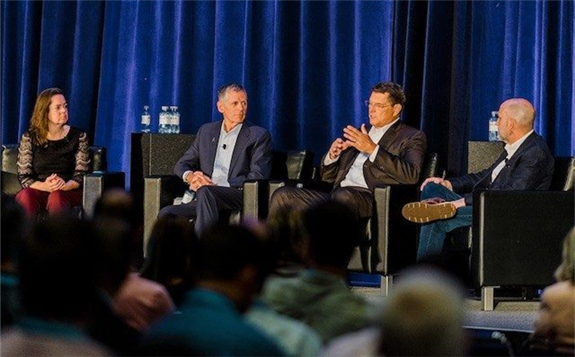
Last week at the HydroVision International plenary session, a panel of three CEOs — Darrel T. Anderson, President and CEO IDACORP and Idaho Power, Mitch Davidson, CEO and Managing Partner, Brookfield Renewable Power, and Paul Jacob, President and CEO, Rye Development — along with moderator Elizabeth Ingram, Content Director, Clarion Energy, discussed both the merits and the challenges of hydropower development in the United States and Canada.
The panel agreed that one of the most important aspects of hydropower is its ability to perform alongside intermittent renewables, firming up power when the wind stops blowing or the sun stops shining. Anderson said the Idaho Power gets about 46% of its power from hydro. He pointed out that Hells Canyon is deeper than the Grand Canyon.
“The reservoir system is the biggest battery in the world,” he said.
Davidson said that Brookfield is working on trying to capture the true value of hydro as essential to increasing renewables. “As natural gas is pushed out of the stack, something has to fill that capacity stack and hydro is the number one resource that can do it,” he said.
Rye Development’s Jacobs said his company is mostly looking to develop hydropower on non-powered dams.
“What underlies our development is the integration of intermittent renewables with hydropower,” he said, adding, “the fact that wind or solar doesn’t perform according to expectations isn’t news to anyone. That’s why the opportunity for pumped storage is so huge.”
Large opportunity, large challenges
While hydropower seems to be the perfect resource for a world that wants emission-free energy sources, it’s not getting the recognition that it needs. For example, Idaho Power has been working to renew its FERC license for its Hells Canyon complex since 2005 and will have spent over $1B on the process once its complete, said Anderson. Neighboring states Oregon and Idaho have been battling over salmon and fish relocation, which has been part of the holdup.
Davidson believes that hydropower should be recognized as a renewable resource. In New England, it isn’t.
“We need fair and reasonable representation as a Tier 1 or Tier 2 REC,” he said.
“We get nothing right now in New England. When we get re-licensed, we should be treated like a brand-new resource, and get tax credits to support it,” he added.
For Jacob, the biggest problem his company faces is access to capital. He said the long development process and the lack of visibility stymie potential investors and financiers.
“The reason you don’t see more developers here [at HydroVision] is because the pace of hydropower development is too slow,” he said, adding “Sierra Club says hydro isn’t a renewable resource. That’s our failing.”